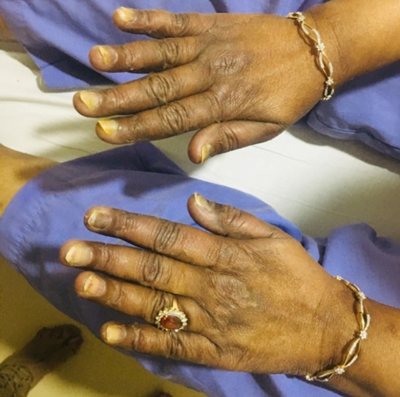Introduction
Several anticancer agents are known to cause adverse reactions of which hand-foot syndrome (HFS) is a common occurrence. HFS is also known as acral erythema or palmoplantar dysesthesia. Drugs such as 5 flurouracil, capecitabine, vinorelbine, methotrexate, cyclophosphamide, and liposomal doxorubicin are known to cause HFS.1 But cases of paclitaxel causing HFS are rare. Clinical manifestations of erythema, dysesthesia or paresthesia with pain, and swelling, and in severe cases, blister formation and ulcerations can be seen. Here, we present such a rare case of HFS in a female with squamous cell carcinoma of buccal mucosa on paclitaxel.
Case Report
A 70-year-old woman, without any comorbidities was diagnosed with advanced metastatic squamous cell carcinoma of the left buccal mucosa. She was started on palliative chemotherapy with injectable paclitaxel (80 mg/m2) and carboplatin (AUC 2) in a weekly dose schedule. She tolerated the first 4 doses without any major toxicities. But after her fifth dose of chemotherapy, she started developing erythema over the dorsal aspect of her Hands and feet along with swelling. The patient also started complaining of a mild tingling sensation over the tips of the fingers (peripheral neuropathy WHO grade 1). The symptoms started slowly but gradually progressed over the next 2 weeks leading to blistering and ulceration (Figure 1). She was diagnosed with HFS grade 3 as per WHO criteria. Symptomatic treatment was started with moisturizing creams, topical agents, and vitamin B6 (pyridoxine).
As per the literature review, paclitaxel has been reported to cause HFS though rare, while the other drug; carboplatin has no reports of any case of HFS. The patient responded to the treatment and gradually recovered over the next 2-3 weeks. Since the intent of the treatment was palliative, the patient was not rechallenged with paclitaxel and the chemotherapy protocol was changed.
Discussion
Paclitaxel belongs to the taxanes group of drugs which play a key role in inhibiting mitosis and hence shows promising results in breast, lungs, ovaries, prostate, head, and neck cancer. It was first used in 1957 as a chemotherapeutic drug and since then several dermatological adverse effects have been reported such as alopecia totalis, mucositis, onycholysis, and lesions like scleroderma. However, HFS is a rare adverse effect of paclitaxel with scarcely reported cases in the literature.
Several mechanisms are involved in the development of paclitaxel-induced HFS. The involvement of hands and soles only could be due to the anatomy and greater number of blood capillaries in these areas, temperature gradient, leaking of the drug from the capillaries of the hands and feet; secretion of chemotherapy drugs from the eccrine glands, and higher turnover of the epidermal basal cells.2 The clinical presentation could manifest within 24 hours of dosage or from the first cycle and reports of late development of symptoms are seen during subsequent cycles or almost 10 months post discontinuation.3 In a case by Payne et al. patient developed severe grade 4 symptoms 8 days after the bolus dose which is the earliest4 Here, the exaggeration after a single dose was postulated to the hypoabuminemia due to hepatic dysfunction in the patient.
The complaints begin with tingling, numbness, dysesthesia or paresthesia, swelling and if untreated might progress to blistering, ulceration, and pain restricting daily functions and thereby hampering the quality of life. Histologically the lesion shows the presence of dyskeratotic keratinocytes, degeneration of the basal layer with vacuoles and the infiltrate consists chiefly of lichenoid lymphocytes. The severity can be decided with help of grading of HFS according to the National Cancer Institute and World Health Organization criteria.5
In the above-presented case, the patient was on Paclitaxel and carboplatin, but since no data of the later causing HFS is reported in the literature; the causality relation between paclitaxel and development of HFS was confirmed. The symptoms started after the fifth dose and initially, she presented with erythema, swelling, and peripheral neuropathy but later progressed to grade 3 severity with blisters and ulcerations.
Management is symptomatic along with either dose reduction or temporary discontinuation of paclitaxel. Post discontinuation of the drug, the symptoms resolve gradually and, in few cases, skin pigmentation remains. Frozen gloves, emollient is used to improve the skin barrier and oral pyridoxine is also advised. In severe cases, systemic or topical steroids are administered and in cases with severe pain; lidocaine patches are prescribed. The patient is advised to avoid sun exposure and mechanical stress. The chemotherapy regime could be altered or safely recontinued to paclitaxel as was suggested in a case reported by Assi et al.6 But since in our case, the patient had advanced metastatic cancer and the intent of treatment was palliation; the patient was not rechallenged with paclitaxel.
Conclusion
Early identification and treatment of dermatological adverse reactions in patients on anticancer drugs is essential to avoid deterioration of their quality of life. Knowledge of such adverse reactions along with rare cases such as HFS is essential to avoid confusion with bacterial or fungal infections. Dose modification or discontinuation is decided as per the individual case, stage of disease, and severity of adverse events.

